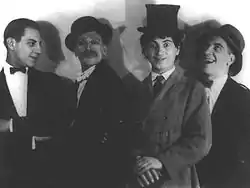Humor Risk
Humor Risk, also known as Humorisk, is a lost unreleased 1921 silent comedy short film that was the first film to star the Marx Brothers. The print may have been accidentally thrown away when left in the screening box overnight.[1] Another version of the story says that Groucho Marx, unhappy with the film's quality, intentionally burned the negative after a particularly bad premiere screening.
| Humor Risk | |
|---|---|
 | |
| Directed by | Dick Smith |
| Produced by | The Marx Brothers Al Posen Max Lippman Jo Swerling |
| Written by | Jo Swerling |
| Starring | Chico Marx Groucho Marx Harpo Marx Zeppo Marx Jobyna Ralston |
| Cinematography | A. H. Vallet |
| Distributed by | Caravel Comedies |
Running time | 2 reels |
| Country | United States |
| Language | Silent film English intertitles |
Humor Risk was directed by comedy film director Dick Smith (1886-1937), and was the first film written by Jo Swerling, who later co-wrote It's a Wonderful Life, Gone with the Wind and many other films. It was filmed in Fort Lee, New Jersey. The film's title was a spoof of the Fannie Hurst drama Humoresque, one of the biggest film hits of 1920.
The Marx Brothers would finally find success in motion pictures with The Cocoanuts (1929).
Cast
Four of the five Marx Brothers are known to have been in this short film. Jobyna Ralston is most often mentioned as the female lead. However, some sources say that Mildred Davis—star and later wife of Harold Lloyd—was also in the film. The websites Marxology and SilentEra both state that the leading lady could have been one of two other actresses, Esther Ralston or Helen Kane.[2]
Synopsis
Information about the plot of the film is sparse.[3] It is known that the brothers were working separately, rather than as a team, and did not incorporate their trademark comic personalities for which they later became known.
Harpo played the hero, a detective named Watson who "made his entrance in a high hat, sliding down a coal chute into the basement". Groucho played an "old movie" villain, who "sported a long moustache and was clad in black", while Chico was probably his "chuckling [Italian] henchman". Zeppo portrayed a playboy who was the owner of a nightclub in which most of the action took place, including "a cabaret, [which allowed] the inclusion of a dance number". The final shot showed Groucho "in ball and chain, trudging slowly off into the gloaming". Harpo, in a rare moment of romantic glory, gets the girl in the end.[4]
References
- Monkey Business: The Lives and Legends of the Marx Brothers (Hardcover), Simon Louvish. Thomas Dunne Books; 1st U.S. edition (2000).
- "Silent Era : Progressive Silent Film List". www.silentera.com.
- Getting the Big Picture; The Film Industry Started Here and Left. Now It's Back, and the State Says the Sequel Is Huge. – New York Times. Nytimes.com (October 4, 1998). Retrieved on 2011-01-10.
- "Humor Risk". Marxology. Retrieved April 2, 2007.
External links
- The Marx Brothers’ Lost Film, Humor Risk: Getting to the Bottom of a Mystery in-depth Brenton Film article on the background and whereabouts of the film
- Marxology entry for Humor Risk
- Humor Risk at IMDb
- Humor Risk at SilentEra
